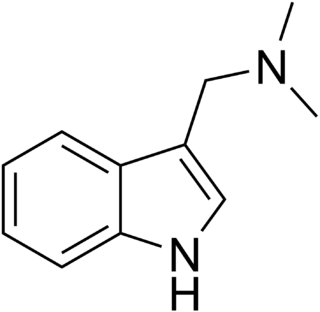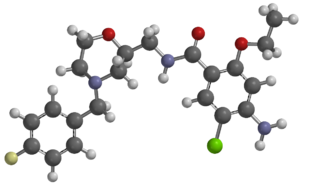
Gramine is a naturally occurring indole alkaloid present in several plant species. Gramine may play a defensive role in these plants, since it is toxic to many organisms.

Astemizole was a second-generation antihistamine drug that has a long duration of action. Astemizole was discovered by Janssen Pharmaceutica in 1977. It was withdrawn from the market globally in 1999 because of rare but potentially fatal side effects.

Parthenolide is a sesquiterpene lactone of the germacranolide class which occurs naturally in the plant feverfew, after which it is named, and in the closely related tansy. It is found in highest concentration in the flowers and fruit. Parthenolide's molecular structure depiction is often incorrect regarding the stereochemistry of the epoxide, although X-ray single crystal structures are available.

Matairesinol is an organic compound. It is classified as a lignan, i.e., a type of phenylpropanoid. It is present in some cereals, e.g. rye, and together with Secoisolariciresinol, has attracted much attention for its beneficial nutritional effects.

Mosapride is a gastroprokinetic agent that acts as a selective 5HT4 agonist. The major active metabolite of mosapride, known as M1, additionally acts as a 5HT3 antagonist, which accelerates gastric emptying throughout the whole of the gastrointestinal tract in humans, and is used for the treatment of gastritis, gastroesophageal reflux disease, functional dyspepsia and irritable bowel syndrome. It is recommended to be taken on an empty stomach (i.e. at least one hour before food or two hours after food).

Adiponectin receptor 1 (AdipoR1) is a protein which in humans is encoded by the ADIPOR1 gene. It is a member of the progestin and adipoQ receptor (PAQR) family, and is also known as PAQR1.

Arctigenin is a lignan found in certain plants of the Asteraceae, including the greater burdock and Saussurea heteromalla. It has shown antiviral and anticancer effects in vitro. It is the aglycone of arctiin.

Arctiin is a lignan found in many plants of the family Asteraceae, particularly the greater burdock and Centaurea imperialis, and in Trachelospermum asiaticum, Saussurea heteromalla, and Forsythia viridissima. It is the glucoside of arctigenin.

Trace amine-associated receptor 5 is a protein that in humans is encoded by the TAAR5 gene. In vertebrates, TAAR5 is expressed in the olfactory epithelium.
Imidazoline receptors are the primary receptors on which clonidine and other imidazolines act. There are three main classes of imidazoline receptor: I1 is involved in inhibition of the sympathetic nervous system to lower blood pressure, I2 has as yet uncertain functions but is implicated in several psychiatric conditions, and I3 regulates insulin secretion.

The GABAA beta-2 subunit is a protein that in humans is encoded by the GABRB2 gene. It combines with other subunits to form the ionotropic GABAA receptors. GABA system is the major inhibitory system in the brain, and its dominant GABAA receptor subtype is composed of α1, β2, and γ2 subunits with the stoichiometry of 2:2:1, which accounts for 43% of all GABAA receptors. Alternative splicing of the GABRB2 gene leads at least to four isoforms, viz. β2-long (β2L) and β2-short. Alternatively spliced variants displayed similar but non-identical electrophysiological properties. GABRB2 is subjected to positive selection and known to be both an alternative splicing and a recombination hotspot; it is regulated via epigenetic regulation including imprinting and gene and promoter methylation GABRB2 has been associated with a number of neuropsychiatric disorders, and found to display altered expression in cancer.

Adiponectin receptor 2 (AdipoR2) is a protein which in humans is encoded by the ADIPOR2 gene. It is a member of the progestin and adipoQ receptor (PAQR) family, and is also known as PAQR2.

SKF-83,959 is a synthetic benzazepine derivative used in scientific research which acts as an agonist at the D1–D2 dopamine receptor heteromer. It behaves as a full agonist at the D1 protomer and a high-affinity partial agonist at the D2 protomer. It was further shown to act as an allosteric modulator of the sigma-1 receptor. SKF-83,959 additionally inhibits sodium channels as well as delayed rectifier potassium channels. SKF-83,959 is a racemate that consists of the R-(+)- and S-(−)-enantiomers MCL-202 and MCL-201, respectively.

The melanocortin 1 receptor (MC1R), also known as melanocyte-stimulating hormone receptor (MSHR), melanin-activating peptide receptor, or melanotropin receptor, is a G protein–coupled receptor that binds to a class of pituitary peptide hormones known as the melanocortins, which include adrenocorticotropic hormone (ACTH) and the different forms of melanocyte-stimulating hormone (MSH). It is coupled to Gαs and upregulates levels of cAMP by activating adenylyl cyclase in cells expressing this receptor. It is normally expressed in skin and melanocytes, and to a lesser degree in periaqueductal gray matter, astrocytes and leukocytes. In skin cancer, MC1R is highly expressed in melanomas but not carcinomas.
Menerba, also known as Menopause Formula 101 (MF-101), is a botanical drug candidate that acts as a selective estrogen receptor modulator (SERM) which is being studied for its potential to relieve hot flashes associated with menopause. Menerba, an estrogen receptor beta (ERβ) agonist (ERBA), is part of a new class of receptor subtype-selective estrogens, which is selective in transcriptional regulation to one of the two known estrogen receptor (ER) subtypes. Menerba consists of 22 herbs that have been used historically in traditional Chinese medicine.
In molecular biology mir-71 microRNA is a short RNA molecule. MicroRNAs function to regulate the expression levels of other genes by several mechanisms.
In molecular biology mir-397 microRNA is a short RNA molecule. MicroRNAs function to regulate the expression levels of other genes by several mechanisms.

Tropoflavin, also known as 7,8-dihydroxyflavone, is a naturally occurring flavone found in Godmania aesculifolia, Tridax procumbens, and primula tree leaves. It has been found to act as a potent and selective small-molecule agonist of the tropomyosin receptor kinase B (TrkB), the main signaling receptor of the neurotrophin brain-derived neurotrophic factor (BDNF). Tropoflavin is both orally bioavailable and able to penetrate the blood–brain barrier. A prodrug of tropoflavin with greatly improved potency and pharmacokinetics, R13, is under development for the treatment of Alzheimer's disease.

AdipoRon is a selective, orally active, synthetic small-molecule agonist of the adiponectin receptor 1 (AdipoR1) and adiponectin receptor 2 (AdipoR2). It activates AMPK and PPARα signaling and ameliorates insulin resistance, dyslipidemia, and glucose intolerance in db/db mice. Moreover, AdipoRon has been found to extend the lifespans of db/db mice fed a high-fat diet, as well as improve exercise endurance. The compound was discovered by Japanese researchers in 2013 via screening of a compound library, and is the first orally active, small-molecule agonist of the adiponectin receptors to be identified.

Deoxygedunin, or 14,15-deoxygedunin, is a naturally occurring tetranortriterpenoid isolated from the Indian neem tree, a plant that has been used in India since ancient times as a remedy for various ailments. Deoxygedunin has been found to act as a potent, selective, small-molecule agonist of TrkB, the main receptor of brain-derived neurotrophic factor (BDNF). It produces TrkB-dependent neurotrophic and neuroprotective effects in mice and enhances learning processes. In addition, deoxygedunin evokes rapid TrkB-dependent antidepressant-like effects in the forced swim test, an animal model of depression, similarly to 7,8-dihydroxyflavone (7,8-DHF) and ketamine, and notably with a greater potency than 7,8-DHF. The compound was discovered by the same group that identified 7,8-DHF and N-acetylserotonin as TrkB agonists.
















